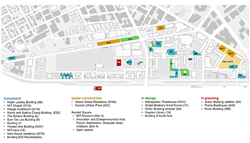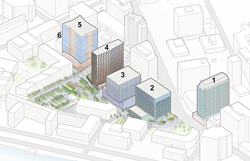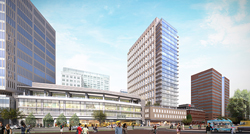
| Vol.
XXXI No.
2 November / December 2018 |
| contents |
| Printable Version |
Update on Construction Across Campus
Our built environment is changing at MIT, as evidenced by the cranes and construction crews around campus. This phase of intensive renewal and selective new construction will continue to bring noticeable changes as the Institute restores its infrastructure and establishes new facilities that will help the MIT community learn and thrive. As we take note of current progress, we share with you the following updates about construction and planning activities on campus.
MIT’s 2030 capital planning framework is unusual among universities for its emphasis on capital renewal projects, including comprehensive building upgrades. Most of the recent projects –capitalized through significant fundraising partnered with low-interest debt – represent MIT’s decision to preserve and invest in its existing buildings.

(click on image to enlarge)
Projects Underway On Campus
Since the implementation of MIT 2030, MIT has completed nearly 480 renewal projects, reaching almost every building on campus to improve building safety, bring older facilities up to code, and implement changes that support teaching and research. Currently, we have 120 smaller-scale renewal projects actively underway.
A larger-scale renewal project, the Central Utilities Plant upgrade – a component of MIT’s Climate Action Plan – will add a second turbine to the plant and install highly efficient equipment and controls designed to reduce on-campus emissions, enhance campus resiliency, and respond to increasing research demands. Having completed the installation of utilities and foundations, crews are now erecting the steel superstructure, installing equipment, and constructing the façade. This phase is expected to continue into the spring of 2019.
New construction on campus, including MIT.nano (Building 12) and the innovative new undergraduate residence on Vassar Street, reflect MIT’s commitment to LEED Gold construction. The new residence will add 450 beds in rooms clustered around shared community spaces such as lounges and study rooms. With foundation and underground utilities work completed, construction will begin this winter on the concrete frame with the assistance of two cranes on site. When completed, this frame will be enclosed by prefabricated exterior panels creating a brick-and-mortar façade.

(click on image to enlarge)
Ongoing Construction for the Kendall Square Initiative
In Kendall Square, the excavation is now giving rise to several buildings, as the Institute continues its work to transform six MIT-owned parking lots into a vibrant, multi-use community for students, faculty, employees, and residents. These locations are currently referred to as Sites 1-6.
- Current construction activities include utility work that touches virtually every system in the area. Sections of Wadsworth, Amherst, and Hayward Streets are experiencing full and partial closures to accommodate excavations and machinery as utilities are relocated or upgraded. This infrastructure work is expected to be complete by January 2019.
- Concurrently, a parking garage is being constructed below ground at Sites 3, 4, and 5. This activity will continue for the next two years as the buildings take shape above.
 Kendall Square Site 1 Rendering
Kendall Square Site 1 Rendering
(click on image to enlarge)
- Foundations are underway at the Site 1 residential building, and initial work has started on the street-level space that – in response to community input – will be occupied by a new Brothers Marketplace grocery store (expected to be completed in the summer of 2019).
- At Site 3, slated for retail use as well as research and development activities, the building foundation is finished and concrete core construction is ongoing.
- A range of uses are planned for Site 4, including graduate student housing, admissions, retail, child care, a Welcome Center, and the Forum. Currently, the concrete framework of the residence hall is going up (the building will be 30 floors in total), and it will soon be enclosed by a façade of metal panels.
- At Site 5 – which recently hosted a ceremonial groundbreaking for the new MIT Museum – construction of the building’s steel structure has begun. Boeing plans to establish the Boeing Aerospace and Autonomy Center at the site, to be operated by Boeing subsidiary and MIT spinout Aurora Flight Sciences.
- Related infrastructure work includes the West Campus Stormwater Improvement Project, which involves the construction of a 1200-foot underground drainage structure from Waverly Street to the Charles River via Amherst Alley. The project was identified by the City of Cambridge and enables MIT to meet our EPA regulations relating to the Kendall Square Initiative. Expected to continue until the summer of 2019, the project will impact Amherst Street from Next House (W71) to Vassar Street alongside the Westgate apartments and parking lot.
At the John A. Volpe National Transportation Systems Center site, MIT is collaborating with state and federal agencies to design the federal government’s new transportation center headquarters. Once this federal building is in place, MIT will proceed with the City of Cambridge-governed process to advance the development of the remaining 10 acres at that site. Site preparation for the federal building is expected to begin this winter.
| Back to top |
Completed Capital Renewal Projects
Smaller-scale capital renewal projects on campus have focused on infrastructure – including roof replacements, building envelope restorations, and upgrades to mechanical systems – and on supporting specific academic programs. For example, a renewal project at the Grainger Energy Machines (GEM) Facility in the basement of Building 10 rejuvenated faculty and student offices, lab areas, and machine shops. Spaces were reconfigured to address programming needs, and new work station fixtures were installed.
Larger-scale capital renewal projects, primarily comprehensive building upgrades, have safeguarded and renewed campus icons like the MIT Chapel (W15), Kresge Auditorium (W16), and the Simons Building (Building 2). Less visible but equally vital, the renovation of two floors in the Muckley Building (E40) improved infrastructure and addressed programmatic needs to support the Center for Transportation & Logistics as it launched a new Blended Master’s Program and the first of MIT’s MicroMaster’s programs.
The ambitious MIT.nano project established a game-changing campus resource designed to support the activities of more than 2,000 faculty and researchers in the fields of nanoscience and nanoengineering. In early October, a grand opening event marked the occasion with a symposium and tours of the building.
At the heart of campus, structural reconfigurations in Building 31 addressed programming needs of the Department of Aeronautics and Astronautics and the Department of Mechanical Engineering by improving internal circulation and adding new specialized lab spaces. On the west end of campus, capital renewal transformed a former warehouse on Vassar Street (Building W97) into an award-winning new home for the Theater Arts program, gathering faculty offices and studios, rehearsal spaces, costume and scene design shops, and adaptable performance spaces under one roof.
Further enhancements to student life on campus were recently implemented with the renovation of MIT’s New House residence (Building W70). The project included substantial infrastructure upgrades, improved accessibility, new amenities such as kitchens and quiet lounges, and other design elements that encourage community and connectivity among the nine cultural houses located within.
Construction Projects in the Pipeline
Several capital renewal projects are moving forward through very early stages, including proposed renovations of the Metropolitan Storage Warehouse, the Hayden Library (Building 14), and the Green Building (Building 54). The Metropolitan Warehouse is slated to serve as an interdisciplinary hub for design and education, providing a new home for the School of Architecture and Planning and for the Project Manus community makerspace. The architect selection process for this project is underway, with a selection expected this winter. The proposed Hayden Library project includes programmatic and infrastructure upgrades and is currently in conceptual design.
Upgrades to the I. M. Pei-designed Green Building – home of the Department of Earth, Atmosphere and Planetary Sciences (EAPS) – are in planning and are expected to include a renewal of the façade and building envelope, replacement of the roof, and updates to the mechanical systems. EAPS-related renovations are also expected to take place on the fourth floor of Building 4 in the form of new wet labs and offices for faculty researchers.
Due to successful fundraising efforts, planning and design activities are also now underway for renovations to MIT’s boathouse and the construction of a new music building on the West Campus. Site selection for the recently announced MIT Stephen Schwarzman College of Computing is also in progress.
Community Engagement and a New Director
of Open Space Programming
While the above summary is a broad overview of current capital renewal efforts on campus, more detailed information is always available on the Capital Projects website. As an additional communications measure, the Kendall Square Initiative posts biweekly construction updates and responds to comments from the community via a coUrbanize web profile (https://courbanize.com/projects/mit-kendall-square/information). Other recent outreach efforts, including events like the Hubweek Kendall Square/MIT Innovation Playground, have provided social opportunities for our campus community, local residents, and members of the Kendall Square community.
Overall, MIT is endeavoring to design buildings and open spaces that similarly invite and welcome the community. In that spirit, we introduce Jessie Schlosser Smith (smithjs@mit.edu), recently hired as MIT’s Director of Open Space Programming. Smith has come on board at MIT specifically to think about the new open spaces in Kendall Square. Her goal is to gather input from a range of collaborators and then design public programs and spaces that engage the community and encourage people to connect with MIT and one another. Some of these activities could advance academic or research goals, and she is eager to meet with faculty to discuss possibilities. We hope you will connect with her.
Additional resources for details of capital renewal projects can be found at:
| Back to top | |
| Send your comments |
| home this issue archives editorial board contact us faculty website |